Education's Impact on Creativity: An Analysis of Conflicting Views
VerifiedAdded on 2023/06/04
|7
|2406
|247
Essay
AI Summary
This essay critically examines the assertion that education stifles creativity, exploring arguments both for and against this claim. It acknowledges that while mainstream education systems may inadvertently hinder creative development through rigid structures and outdated teaching methods, creative education approaches can foster critical thinking, analytical skills, and problem-solving abilities. The essay delves into the views of various researchers and educators, including Ken Robinson, who argue that schools often educate children out of their inherent creativity. Conversely, it also presents arguments suggesting that creativity can be a learned skill, enhanced through knowledge acquisition and exposure to diverse experiences. The essay concludes that while traditional education can be restrictive, the implementation of creative education systems can promote critical thinking and encourage students to utilize their creative thinking abilities. Desklib provides a platform for students to access similar essays and study resources.
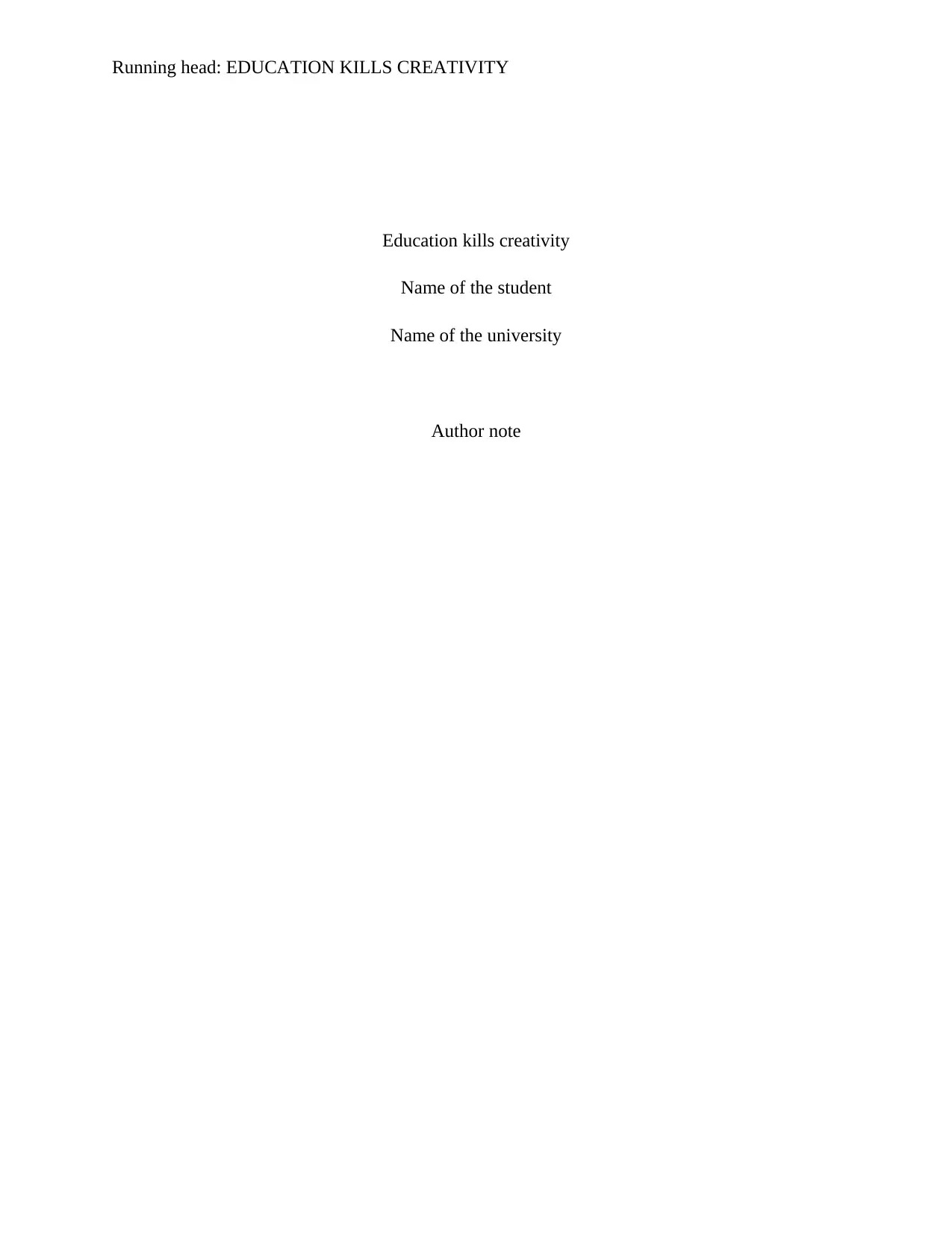
Running head: EDUCATION KILLS CREATIVITY
Education kills creativity
Name of the student
Name of the university
Author note
Education kills creativity
Name of the student
Name of the university
Author note
Paraphrase This Document
Need a fresh take? Get an instant paraphrase of this document with our AI Paraphraser
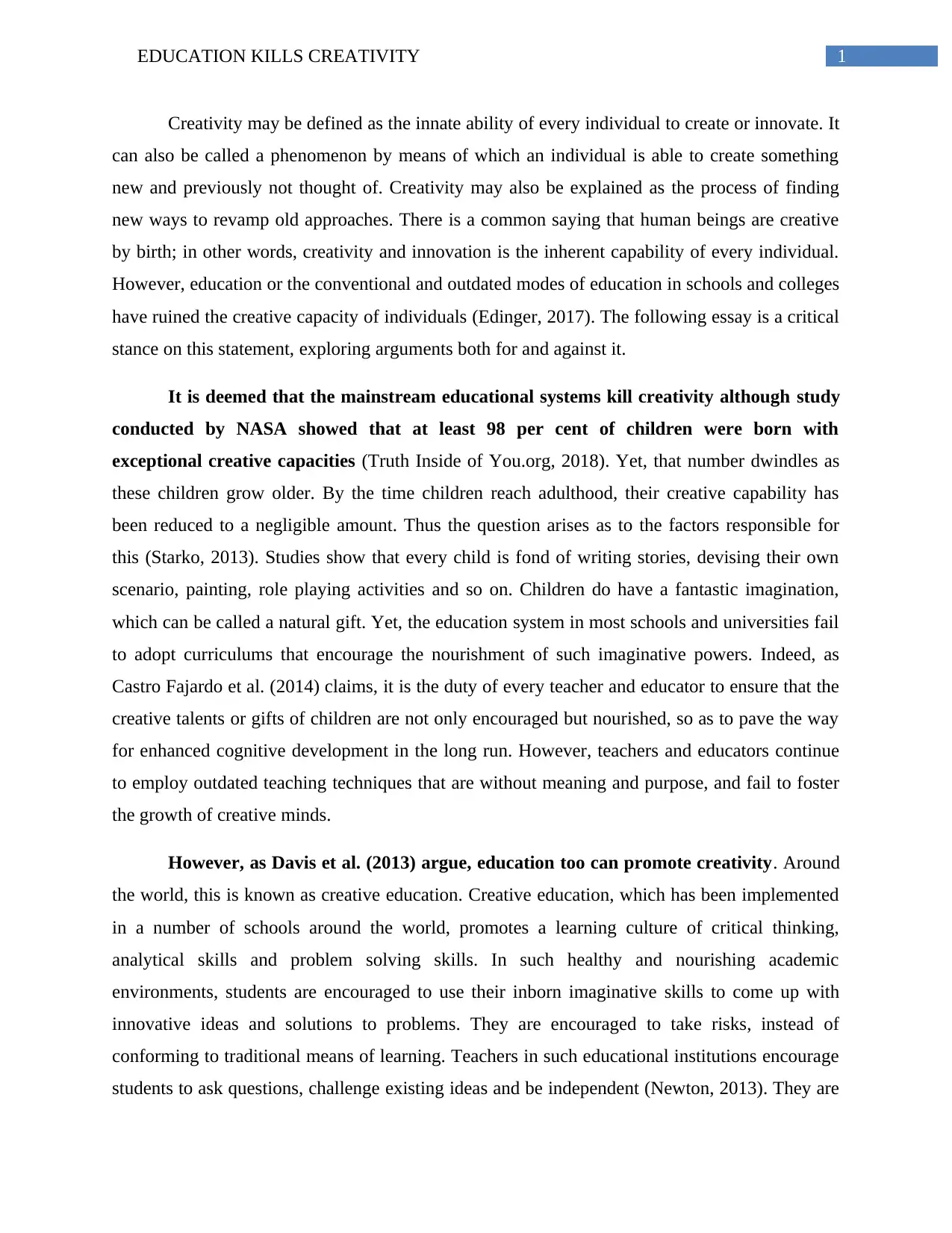
1EDUCATION KILLS CREATIVITY
Creativity may be defined as the innate ability of every individual to create or innovate. It
can also be called a phenomenon by means of which an individual is able to create something
new and previously not thought of. Creativity may also be explained as the process of finding
new ways to revamp old approaches. There is a common saying that human beings are creative
by birth; in other words, creativity and innovation is the inherent capability of every individual.
However, education or the conventional and outdated modes of education in schools and colleges
have ruined the creative capacity of individuals (Edinger, 2017). The following essay is a critical
stance on this statement, exploring arguments both for and against it.
It is deemed that the mainstream educational systems kill creativity although study
conducted by NASA showed that at least 98 per cent of children were born with
exceptional creative capacities (Truth Inside of You.org, 2018). Yet, that number dwindles as
these children grow older. By the time children reach adulthood, their creative capability has
been reduced to a negligible amount. Thus the question arises as to the factors responsible for
this (Starko, 2013). Studies show that every child is fond of writing stories, devising their own
scenario, painting, role playing activities and so on. Children do have a fantastic imagination,
which can be called a natural gift. Yet, the education system in most schools and universities fail
to adopt curriculums that encourage the nourishment of such imaginative powers. Indeed, as
Castro Fajardo et al. (2014) claims, it is the duty of every teacher and educator to ensure that the
creative talents or gifts of children are not only encouraged but nourished, so as to pave the way
for enhanced cognitive development in the long run. However, teachers and educators continue
to employ outdated teaching techniques that are without meaning and purpose, and fail to foster
the growth of creative minds.
However, as Davis et al. (2013) argue, education too can promote creativity. Around
the world, this is known as creative education. Creative education, which has been implemented
in a number of schools around the world, promotes a learning culture of critical thinking,
analytical skills and problem solving skills. In such healthy and nourishing academic
environments, students are encouraged to use their inborn imaginative skills to come up with
innovative ideas and solutions to problems. They are encouraged to take risks, instead of
conforming to traditional means of learning. Teachers in such educational institutions encourage
students to ask questions, challenge existing ideas and be independent (Newton, 2013). They are
Creativity may be defined as the innate ability of every individual to create or innovate. It
can also be called a phenomenon by means of which an individual is able to create something
new and previously not thought of. Creativity may also be explained as the process of finding
new ways to revamp old approaches. There is a common saying that human beings are creative
by birth; in other words, creativity and innovation is the inherent capability of every individual.
However, education or the conventional and outdated modes of education in schools and colleges
have ruined the creative capacity of individuals (Edinger, 2017). The following essay is a critical
stance on this statement, exploring arguments both for and against it.
It is deemed that the mainstream educational systems kill creativity although study
conducted by NASA showed that at least 98 per cent of children were born with
exceptional creative capacities (Truth Inside of You.org, 2018). Yet, that number dwindles as
these children grow older. By the time children reach adulthood, their creative capability has
been reduced to a negligible amount. Thus the question arises as to the factors responsible for
this (Starko, 2013). Studies show that every child is fond of writing stories, devising their own
scenario, painting, role playing activities and so on. Children do have a fantastic imagination,
which can be called a natural gift. Yet, the education system in most schools and universities fail
to adopt curriculums that encourage the nourishment of such imaginative powers. Indeed, as
Castro Fajardo et al. (2014) claims, it is the duty of every teacher and educator to ensure that the
creative talents or gifts of children are not only encouraged but nourished, so as to pave the way
for enhanced cognitive development in the long run. However, teachers and educators continue
to employ outdated teaching techniques that are without meaning and purpose, and fail to foster
the growth of creative minds.
However, as Davis et al. (2013) argue, education too can promote creativity. Around
the world, this is known as creative education. Creative education, which has been implemented
in a number of schools around the world, promotes a learning culture of critical thinking,
analytical skills and problem solving skills. In such healthy and nourishing academic
environments, students are encouraged to use their inborn imaginative skills to come up with
innovative ideas and solutions to problems. They are encouraged to take risks, instead of
conforming to traditional means of learning. Teachers in such educational institutions encourage
students to ask questions, challenge existing ideas and be independent (Newton, 2013). They are
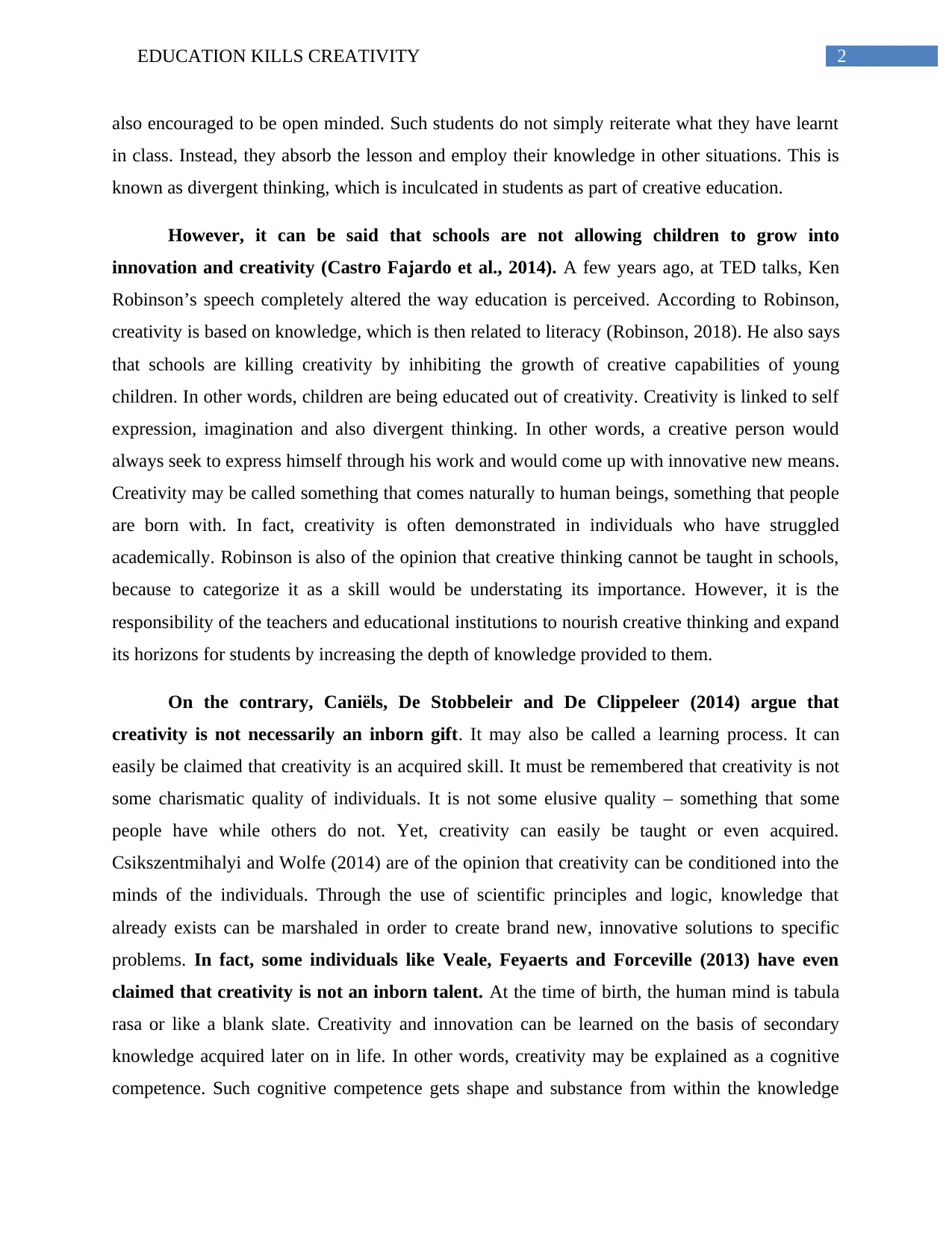
2EDUCATION KILLS CREATIVITY
also encouraged to be open minded. Such students do not simply reiterate what they have learnt
in class. Instead, they absorb the lesson and employ their knowledge in other situations. This is
known as divergent thinking, which is inculcated in students as part of creative education.
However, it can be said that schools are not allowing children to grow into
innovation and creativity (Castro Fajardo et al., 2014). A few years ago, at TED talks, Ken
Robinson’s speech completely altered the way education is perceived. According to Robinson,
creativity is based on knowledge, which is then related to literacy (Robinson, 2018). He also says
that schools are killing creativity by inhibiting the growth of creative capabilities of young
children. In other words, children are being educated out of creativity. Creativity is linked to self
expression, imagination and also divergent thinking. In other words, a creative person would
always seek to express himself through his work and would come up with innovative new means.
Creativity may be called something that comes naturally to human beings, something that people
are born with. In fact, creativity is often demonstrated in individuals who have struggled
academically. Robinson is also of the opinion that creative thinking cannot be taught in schools,
because to categorize it as a skill would be understating its importance. However, it is the
responsibility of the teachers and educational institutions to nourish creative thinking and expand
its horizons for students by increasing the depth of knowledge provided to them.
On the contrary, Caniëls, De Stobbeleir and De Clippeleer (2014) argue that
creativity is not necessarily an inborn gift. It may also be called a learning process. It can
easily be claimed that creativity is an acquired skill. It must be remembered that creativity is not
some charismatic quality of individuals. It is not some elusive quality – something that some
people have while others do not. Yet, creativity can easily be taught or even acquired.
Csikszentmihalyi and Wolfe (2014) are of the opinion that creativity can be conditioned into the
minds of the individuals. Through the use of scientific principles and logic, knowledge that
already exists can be marshaled in order to create brand new, innovative solutions to specific
problems. In fact, some individuals like Veale, Feyaerts and Forceville (2013) have even
claimed that creativity is not an inborn talent. At the time of birth, the human mind is tabula
rasa or like a blank slate. Creativity and innovation can be learned on the basis of secondary
knowledge acquired later on in life. In other words, creativity may be explained as a cognitive
competence. Such cognitive competence gets shape and substance from within the knowledge
also encouraged to be open minded. Such students do not simply reiterate what they have learnt
in class. Instead, they absorb the lesson and employ their knowledge in other situations. This is
known as divergent thinking, which is inculcated in students as part of creative education.
However, it can be said that schools are not allowing children to grow into
innovation and creativity (Castro Fajardo et al., 2014). A few years ago, at TED talks, Ken
Robinson’s speech completely altered the way education is perceived. According to Robinson,
creativity is based on knowledge, which is then related to literacy (Robinson, 2018). He also says
that schools are killing creativity by inhibiting the growth of creative capabilities of young
children. In other words, children are being educated out of creativity. Creativity is linked to self
expression, imagination and also divergent thinking. In other words, a creative person would
always seek to express himself through his work and would come up with innovative new means.
Creativity may be called something that comes naturally to human beings, something that people
are born with. In fact, creativity is often demonstrated in individuals who have struggled
academically. Robinson is also of the opinion that creative thinking cannot be taught in schools,
because to categorize it as a skill would be understating its importance. However, it is the
responsibility of the teachers and educational institutions to nourish creative thinking and expand
its horizons for students by increasing the depth of knowledge provided to them.
On the contrary, Caniëls, De Stobbeleir and De Clippeleer (2014) argue that
creativity is not necessarily an inborn gift. It may also be called a learning process. It can
easily be claimed that creativity is an acquired skill. It must be remembered that creativity is not
some charismatic quality of individuals. It is not some elusive quality – something that some
people have while others do not. Yet, creativity can easily be taught or even acquired.
Csikszentmihalyi and Wolfe (2014) are of the opinion that creativity can be conditioned into the
minds of the individuals. Through the use of scientific principles and logic, knowledge that
already exists can be marshaled in order to create brand new, innovative solutions to specific
problems. In fact, some individuals like Veale, Feyaerts and Forceville (2013) have even
claimed that creativity is not an inborn talent. At the time of birth, the human mind is tabula
rasa or like a blank slate. Creativity and innovation can be learned on the basis of secondary
knowledge acquired later on in life. In other words, creativity may be explained as a cognitive
competence. Such cognitive competence gets shape and substance from within the knowledge
⊘ This is a preview!⊘
Do you want full access?
Subscribe today to unlock all pages.

Trusted by 1+ million students worldwide
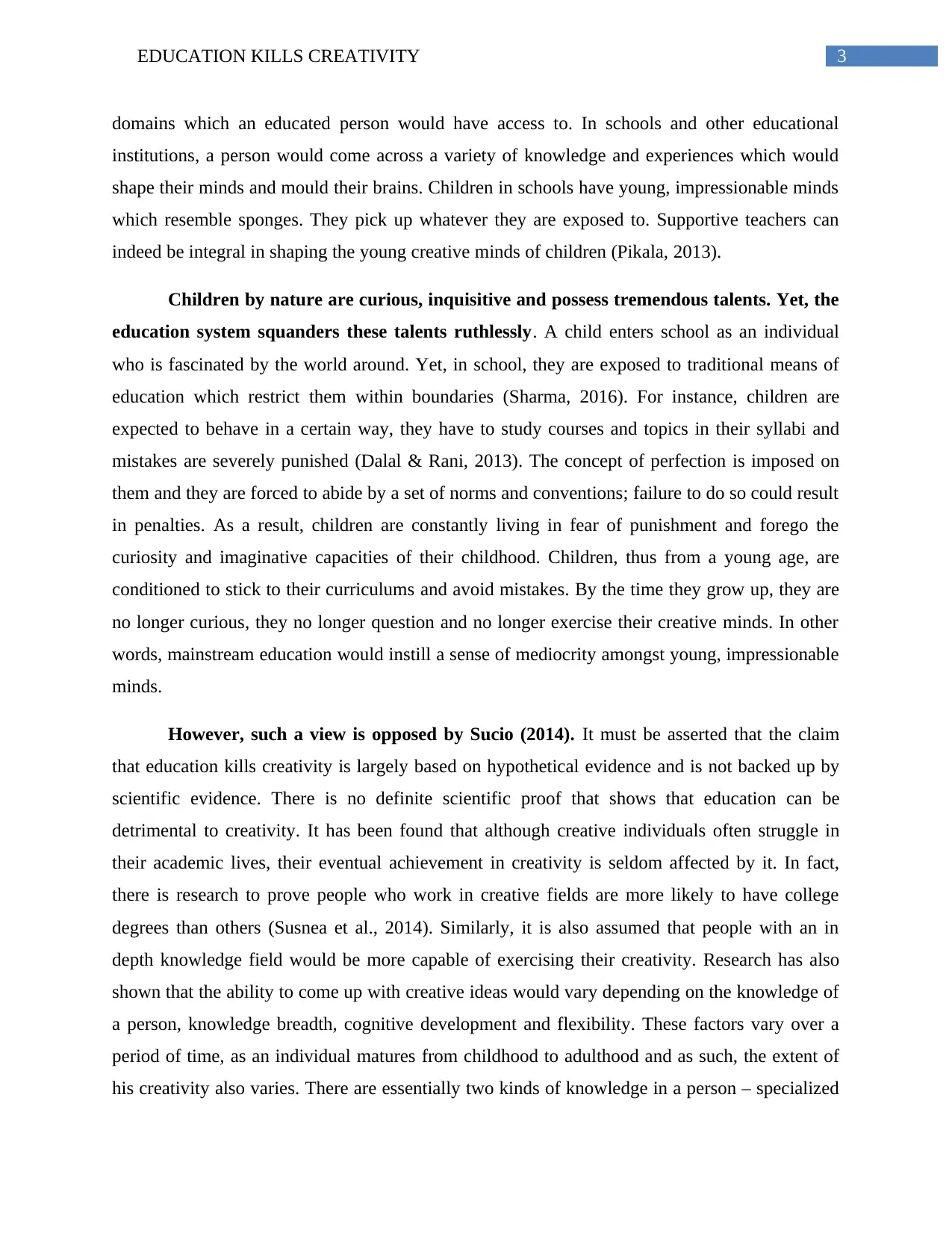
3EDUCATION KILLS CREATIVITY
domains which an educated person would have access to. In schools and other educational
institutions, a person would come across a variety of knowledge and experiences which would
shape their minds and mould their brains. Children in schools have young, impressionable minds
which resemble sponges. They pick up whatever they are exposed to. Supportive teachers can
indeed be integral in shaping the young creative minds of children (Pikala, 2013).
Children by nature are curious, inquisitive and possess tremendous talents. Yet, the
education system squanders these talents ruthlessly. A child enters school as an individual
who is fascinated by the world around. Yet, in school, they are exposed to traditional means of
education which restrict them within boundaries (Sharma, 2016). For instance, children are
expected to behave in a certain way, they have to study courses and topics in their syllabi and
mistakes are severely punished (Dalal & Rani, 2013). The concept of perfection is imposed on
them and they are forced to abide by a set of norms and conventions; failure to do so could result
in penalties. As a result, children are constantly living in fear of punishment and forego the
curiosity and imaginative capacities of their childhood. Children, thus from a young age, are
conditioned to stick to their curriculums and avoid mistakes. By the time they grow up, they are
no longer curious, they no longer question and no longer exercise their creative minds. In other
words, mainstream education would instill a sense of mediocrity amongst young, impressionable
minds.
However, such a view is opposed by Sucio (2014). It must be asserted that the claim
that education kills creativity is largely based on hypothetical evidence and is not backed up by
scientific evidence. There is no definite scientific proof that shows that education can be
detrimental to creativity. It has been found that although creative individuals often struggle in
their academic lives, their eventual achievement in creativity is seldom affected by it. In fact,
there is research to prove people who work in creative fields are more likely to have college
degrees than others (Susnea et al., 2014). Similarly, it is also assumed that people with an in
depth knowledge field would be more capable of exercising their creativity. Research has also
shown that the ability to come up with creative ideas would vary depending on the knowledge of
a person, knowledge breadth, cognitive development and flexibility. These factors vary over a
period of time, as an individual matures from childhood to adulthood and as such, the extent of
his creativity also varies. There are essentially two kinds of knowledge in a person – specialized
domains which an educated person would have access to. In schools and other educational
institutions, a person would come across a variety of knowledge and experiences which would
shape their minds and mould their brains. Children in schools have young, impressionable minds
which resemble sponges. They pick up whatever they are exposed to. Supportive teachers can
indeed be integral in shaping the young creative minds of children (Pikala, 2013).
Children by nature are curious, inquisitive and possess tremendous talents. Yet, the
education system squanders these talents ruthlessly. A child enters school as an individual
who is fascinated by the world around. Yet, in school, they are exposed to traditional means of
education which restrict them within boundaries (Sharma, 2016). For instance, children are
expected to behave in a certain way, they have to study courses and topics in their syllabi and
mistakes are severely punished (Dalal & Rani, 2013). The concept of perfection is imposed on
them and they are forced to abide by a set of norms and conventions; failure to do so could result
in penalties. As a result, children are constantly living in fear of punishment and forego the
curiosity and imaginative capacities of their childhood. Children, thus from a young age, are
conditioned to stick to their curriculums and avoid mistakes. By the time they grow up, they are
no longer curious, they no longer question and no longer exercise their creative minds. In other
words, mainstream education would instill a sense of mediocrity amongst young, impressionable
minds.
However, such a view is opposed by Sucio (2014). It must be asserted that the claim
that education kills creativity is largely based on hypothetical evidence and is not backed up by
scientific evidence. There is no definite scientific proof that shows that education can be
detrimental to creativity. It has been found that although creative individuals often struggle in
their academic lives, their eventual achievement in creativity is seldom affected by it. In fact,
there is research to prove people who work in creative fields are more likely to have college
degrees than others (Susnea et al., 2014). Similarly, it is also assumed that people with an in
depth knowledge field would be more capable of exercising their creativity. Research has also
shown that the ability to come up with creative ideas would vary depending on the knowledge of
a person, knowledge breadth, cognitive development and flexibility. These factors vary over a
period of time, as an individual matures from childhood to adulthood and as such, the extent of
his creativity also varies. There are essentially two kinds of knowledge in a person – specialized
Paraphrase This Document
Need a fresh take? Get an instant paraphrase of this document with our AI Paraphraser

4EDUCATION KILLS CREATIVITY
knowledge and diverse knowledge. As a child, a person has more diverse knowledge than
specialized knowledge. However, as he grows up, he begins to develop preferences and begins to
focus on one area of knowledge. With higher education, the person begins to gain more and more
knowledge about a specific subject (Cerne et al., 2014). Such knowledge would better equip him
to come up with specialized, specific and innovative solutions to problems. Thus, while it can be
said that creativity is inherent, it can also be said that creativity can be enhanced as a result of
knowledge acquisition.
To conclude, it can be said that there is enough argument to suggest that education can be
stifling as far as creativity is concerned. Education around the world has remained constricted to
certain boundaries. It abides by a set of norms and regulations, which inhibit the cognitive
development of young, creative minds. Students are always expected to abide by codes of
perfection, where taking risks is frowned upon. Such modes of education can be potentially
damaging to the creative development of students. However, as of now, most schools have
implemented a system of creative education. Such creative education promotes a degree of
critical thinking and encourages students to employ their creative thinking abilities.
knowledge and diverse knowledge. As a child, a person has more diverse knowledge than
specialized knowledge. However, as he grows up, he begins to develop preferences and begins to
focus on one area of knowledge. With higher education, the person begins to gain more and more
knowledge about a specific subject (Cerne et al., 2014). Such knowledge would better equip him
to come up with specialized, specific and innovative solutions to problems. Thus, while it can be
said that creativity is inherent, it can also be said that creativity can be enhanced as a result of
knowledge acquisition.
To conclude, it can be said that there is enough argument to suggest that education can be
stifling as far as creativity is concerned. Education around the world has remained constricted to
certain boundaries. It abides by a set of norms and regulations, which inhibit the cognitive
development of young, creative minds. Students are always expected to abide by codes of
perfection, where taking risks is frowned upon. Such modes of education can be potentially
damaging to the creative development of students. However, as of now, most schools have
implemented a system of creative education. Such creative education promotes a degree of
critical thinking and encourages students to employ their creative thinking abilities.
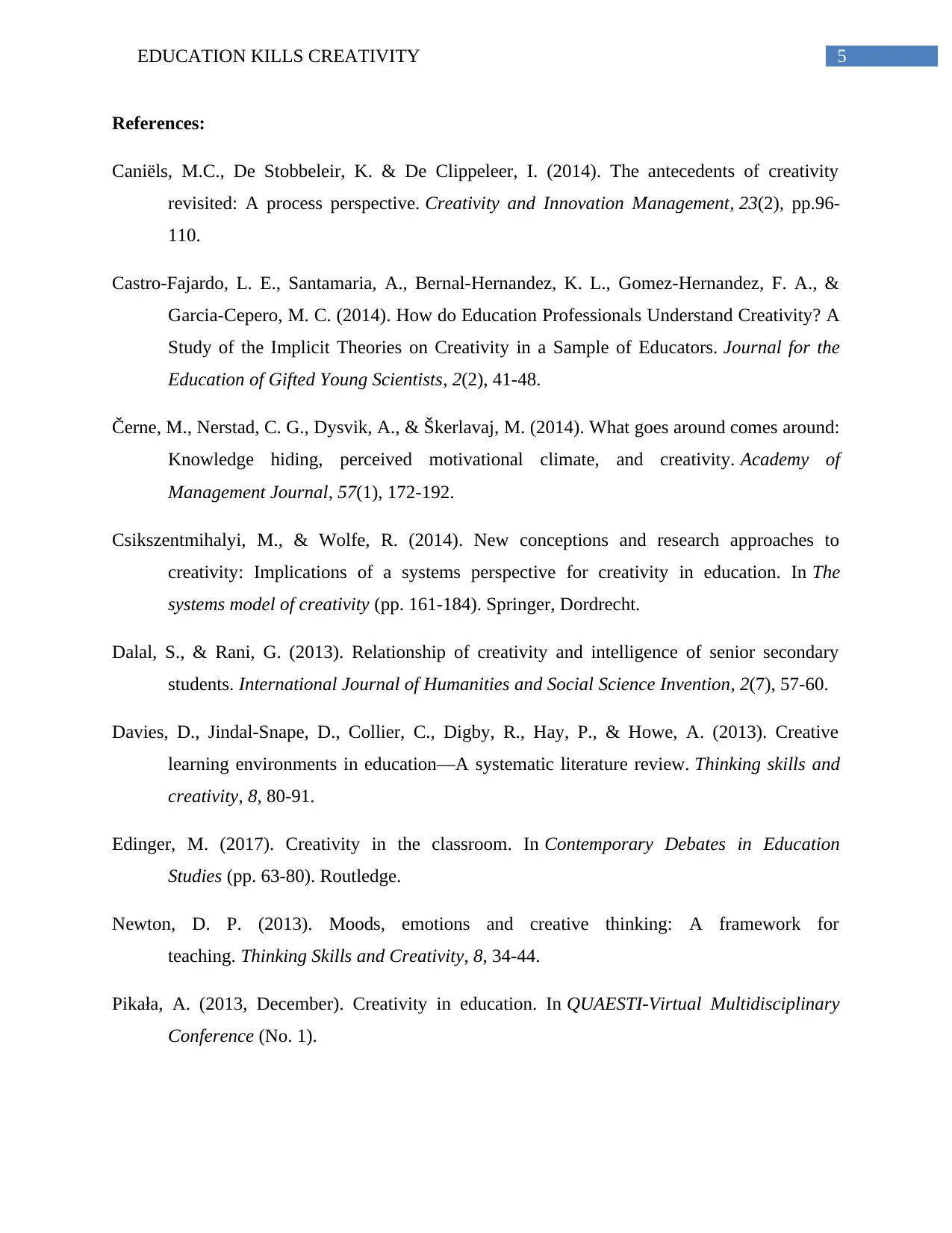
5EDUCATION KILLS CREATIVITY
References:
Caniëls, M.C., De Stobbeleir, K. & De Clippeleer, I. (2014). The antecedents of creativity
revisited: A process perspective. Creativity and Innovation Management, 23(2), pp.96-
110.
Castro-Fajardo, L. E., Santamaria, A., Bernal-Hernandez, K. L., Gomez-Hernandez, F. A., &
Garcia-Cepero, M. C. (2014). How do Education Professionals Understand Creativity? A
Study of the Implicit Theories on Creativity in a Sample of Educators. Journal for the
Education of Gifted Young Scientists, 2(2), 41-48.
Černe, M., Nerstad, C. G., Dysvik, A., & Škerlavaj, M. (2014). What goes around comes around:
Knowledge hiding, perceived motivational climate, and creativity. Academy of
Management Journal, 57(1), 172-192.
Csikszentmihalyi, M., & Wolfe, R. (2014). New conceptions and research approaches to
creativity: Implications of a systems perspective for creativity in education. In The
systems model of creativity (pp. 161-184). Springer, Dordrecht.
Dalal, S., & Rani, G. (2013). Relationship of creativity and intelligence of senior secondary
students. International Journal of Humanities and Social Science Invention, 2(7), 57-60.
Davies, D., Jindal-Snape, D., Collier, C., Digby, R., Hay, P., & Howe, A. (2013). Creative
learning environments in education—A systematic literature review. Thinking skills and
creativity, 8, 80-91.
Edinger, M. (2017). Creativity in the classroom. In Contemporary Debates in Education
Studies (pp. 63-80). Routledge.
Newton, D. P. (2013). Moods, emotions and creative thinking: A framework for
teaching. Thinking Skills and Creativity, 8, 34-44.
Pikała, A. (2013, December). Creativity in education. In QUAESTI-Virtual Multidisciplinary
Conference (No. 1).
References:
Caniëls, M.C., De Stobbeleir, K. & De Clippeleer, I. (2014). The antecedents of creativity
revisited: A process perspective. Creativity and Innovation Management, 23(2), pp.96-
110.
Castro-Fajardo, L. E., Santamaria, A., Bernal-Hernandez, K. L., Gomez-Hernandez, F. A., &
Garcia-Cepero, M. C. (2014). How do Education Professionals Understand Creativity? A
Study of the Implicit Theories on Creativity in a Sample of Educators. Journal for the
Education of Gifted Young Scientists, 2(2), 41-48.
Černe, M., Nerstad, C. G., Dysvik, A., & Škerlavaj, M. (2014). What goes around comes around:
Knowledge hiding, perceived motivational climate, and creativity. Academy of
Management Journal, 57(1), 172-192.
Csikszentmihalyi, M., & Wolfe, R. (2014). New conceptions and research approaches to
creativity: Implications of a systems perspective for creativity in education. In The
systems model of creativity (pp. 161-184). Springer, Dordrecht.
Dalal, S., & Rani, G. (2013). Relationship of creativity and intelligence of senior secondary
students. International Journal of Humanities and Social Science Invention, 2(7), 57-60.
Davies, D., Jindal-Snape, D., Collier, C., Digby, R., Hay, P., & Howe, A. (2013). Creative
learning environments in education—A systematic literature review. Thinking skills and
creativity, 8, 80-91.
Edinger, M. (2017). Creativity in the classroom. In Contemporary Debates in Education
Studies (pp. 63-80). Routledge.
Newton, D. P. (2013). Moods, emotions and creative thinking: A framework for
teaching. Thinking Skills and Creativity, 8, 34-44.
Pikała, A. (2013, December). Creativity in education. In QUAESTI-Virtual Multidisciplinary
Conference (No. 1).
⊘ This is a preview!⊘
Do you want full access?
Subscribe today to unlock all pages.

Trusted by 1+ million students worldwide
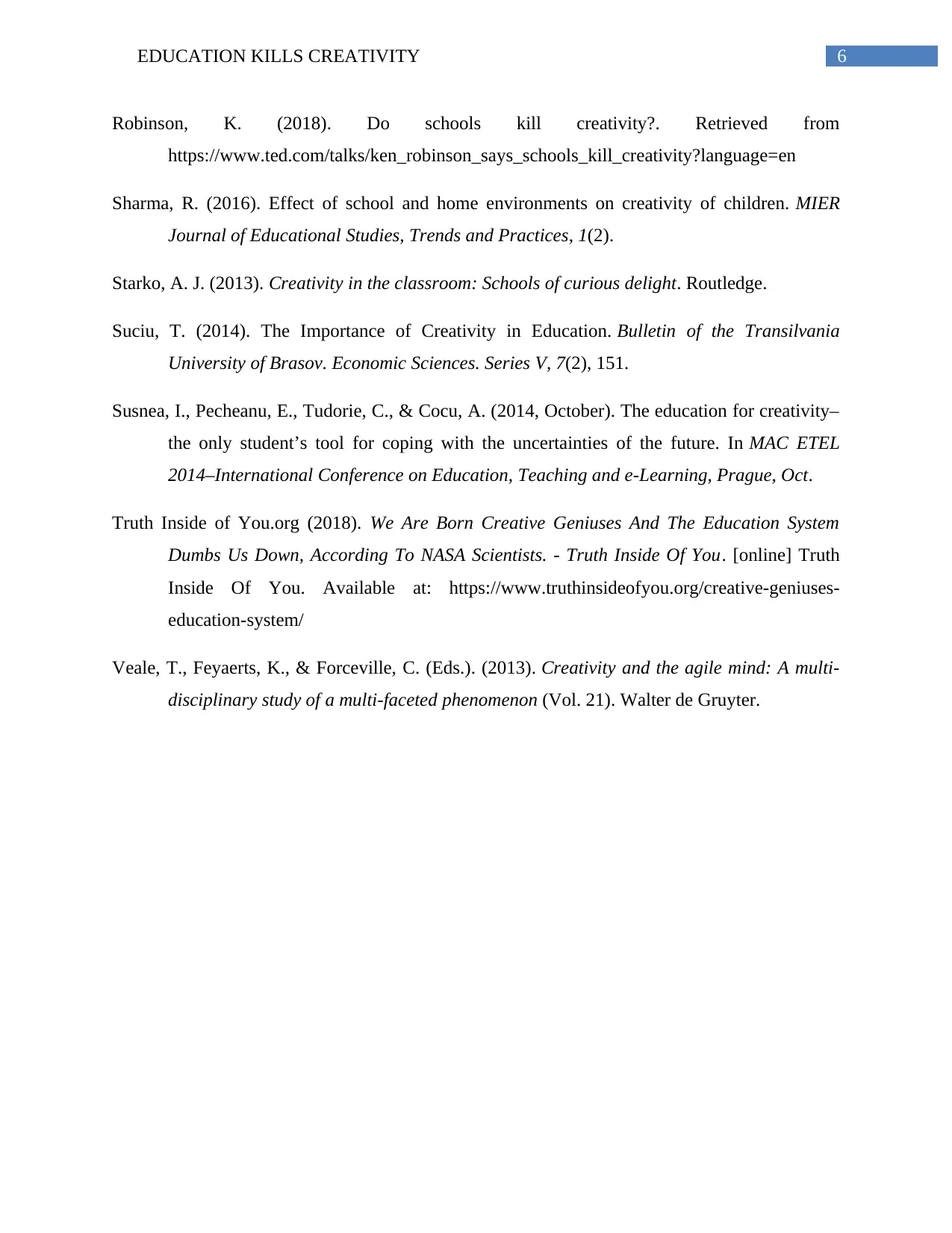
6EDUCATION KILLS CREATIVITY
Robinson, K. (2018). Do schools kill creativity?. Retrieved from
https://www.ted.com/talks/ken_robinson_says_schools_kill_creativity?language=en
Sharma, R. (2016). Effect of school and home environments on creativity of children. MIER
Journal of Educational Studies, Trends and Practices, 1(2).
Starko, A. J. (2013). Creativity in the classroom: Schools of curious delight. Routledge.
Suciu, T. (2014). The Importance of Creativity in Education. Bulletin of the Transilvania
University of Brasov. Economic Sciences. Series V, 7(2), 151.
Susnea, I., Pecheanu, E., Tudorie, C., & Cocu, A. (2014, October). The education for creativity–
the only student’s tool for coping with the uncertainties of the future. In MAC ETEL
2014–International Conference on Education, Teaching and e-Learning, Prague, Oct.
Truth Inside of You.org (2018). We Are Born Creative Geniuses And The Education System
Dumbs Us Down, According To NASA Scientists. - Truth Inside Of You. [online] Truth
Inside Of You. Available at: https://www.truthinsideofyou.org/creative-geniuses-
education-system/
Veale, T., Feyaerts, K., & Forceville, C. (Eds.). (2013). Creativity and the agile mind: A multi-
disciplinary study of a multi-faceted phenomenon (Vol. 21). Walter de Gruyter.
Robinson, K. (2018). Do schools kill creativity?. Retrieved from
https://www.ted.com/talks/ken_robinson_says_schools_kill_creativity?language=en
Sharma, R. (2016). Effect of school and home environments on creativity of children. MIER
Journal of Educational Studies, Trends and Practices, 1(2).
Starko, A. J. (2013). Creativity in the classroom: Schools of curious delight. Routledge.
Suciu, T. (2014). The Importance of Creativity in Education. Bulletin of the Transilvania
University of Brasov. Economic Sciences. Series V, 7(2), 151.
Susnea, I., Pecheanu, E., Tudorie, C., & Cocu, A. (2014, October). The education for creativity–
the only student’s tool for coping with the uncertainties of the future. In MAC ETEL
2014–International Conference on Education, Teaching and e-Learning, Prague, Oct.
Truth Inside of You.org (2018). We Are Born Creative Geniuses And The Education System
Dumbs Us Down, According To NASA Scientists. - Truth Inside Of You. [online] Truth
Inside Of You. Available at: https://www.truthinsideofyou.org/creative-geniuses-
education-system/
Veale, T., Feyaerts, K., & Forceville, C. (Eds.). (2013). Creativity and the agile mind: A multi-
disciplinary study of a multi-faceted phenomenon (Vol. 21). Walter de Gruyter.
1 out of 7
Related Documents
Your All-in-One AI-Powered Toolkit for Academic Success.
+13062052269
info@desklib.com
Available 24*7 on WhatsApp / Email
![[object Object]](/_next/static/media/star-bottom.7253800d.svg)
Unlock your academic potential
Copyright © 2020–2025 A2Z Services. All Rights Reserved. Developed and managed by ZUCOL.





